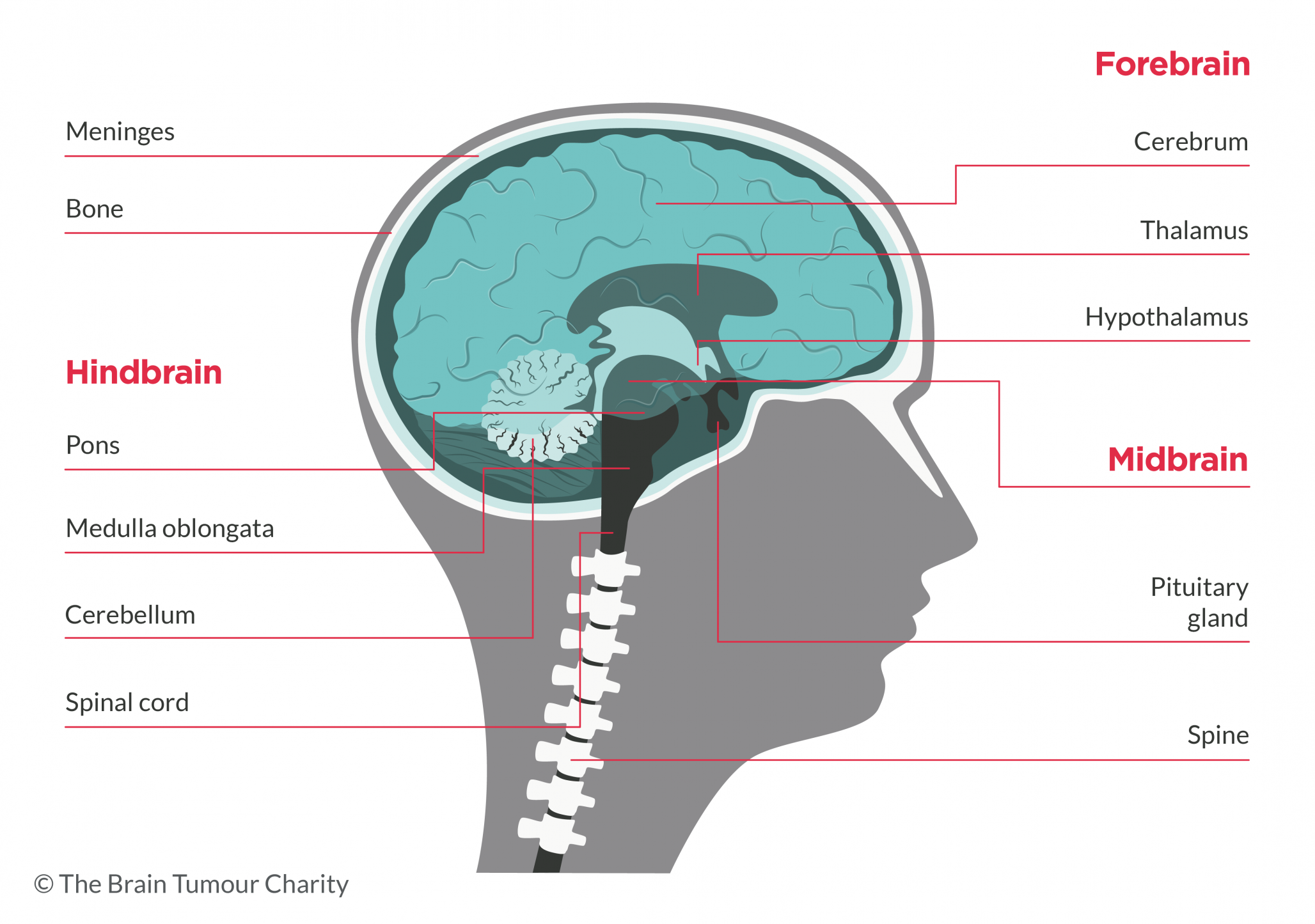The human brain
The brain is the centre of our nervous section and the most complex organ in our body. It’s responsible for every thought and memory we have, every feeling we experience and every action we take.
On this page:
About the brain
The brain is made up of around 100 billion nerve cells, with each one connected to another 10,000 – that’s around 1,000 trillion connections. These are ultimately responsible for who we are, controlling the decisions we make, the way we learn, how we move and what we feel.
What makes the human brain unique is its size. Our brains have a larger cerebral cortex relative to the rest of the brain than any other animal. This gives us abilities like complex language, problem solving and self-control.
The brain is protected by the thick bones of our skull and a protective and nourishing fluid called ‘cerebrospinal fluid’ (CSF). It is separated from the rest of the body’s bloodstream by the blood-brain barrier. This protects the brain from infection and helps keep the environment stable.

The cerebral cortex
Also known as the cerebrum or forebrain, the cerebral cortex is the largest part of the brain. It is split into two halves of roughly equal size called hemispheres.
The left and right hemispheres are joined together by a bundle of nerve fibres. Medical experts call them the corpus callosum. The right hemisphere controls the left side of the body and the left hemisphere controls the right side of the body.
The cerebrum further divides into four lobes:
Each lobe has different functions and a tumour located in a particular lobe could cause problems related to the functions performed by that lobe.

Frontal lobe
The frontal lobe is the largest lobe and is located at the front of the brain. It plays a huge role in what we do and who we are. It controls our personality, emotions, memory, behaviour and movements.
The frontal lobe helps us with planning and organising, problem-solving and decision-making, concentration and thinking through the consequences of our actions as well as understanding social norms. A tumour in the frontal lobe can affect our cognitive skills, sight, smell and personality.
Within the frontal lobe there are two further specialised areas – the motor cortex and Broca’s area. A tumour may affect their functions.
Motor cortex
The motor cortex helps to control and co-ordinate how we move.
Broca’s area
Broca’s area is responsible for producing language and a tumour in this area can cause speech or language difficulties.
Temporal lobe
The temporal lobe is located right behind the temples, in the middle of the lower half of the brain.
A complex part, it is involved in many of the more complex cognitive functions, such as memory, learning, understanding other people’s emotions, controlling your own emotions and behaviour. It also has a large role in hearing.
A tumour in the temporal lobe can make it difficult to form new memories, control our emotions and cause difficulties with speech and hearing.
Wernicke’s area
Sitting mainly in the temporal lobe, but next to the parietal lobe, is Wernicke’s area. It’s usually in the left hemisphere of the brain, but not always.
Wenicke’s area is essential for understanding speech and written words. Any damage to this area can result in communication difficulties.
Parietal lobe
The parietal lobe sits directly behind the frontal lobe at the top of the brain and includes the area known as the sensory cortex. It also borders and affects Wernicke’s area.
The sensory cortex receives information from our senses, such as touch, pain and pressure. It also helps us to respond to internal sensations.
The parietal lobe uses this sensory information to give us spatial awareness, helping us understand the distance between two objects and where our body is in space. This is known as proprioception and it helps us navigate the world around us.
A tumour in the parietal lobe can cause difficulties in writing, speaking and understanding speech, as well as affect your ability to find your way around.
Occipital lobe
The occipital lobe is the smallest lobe and is located towards the very rear of the skull.
The primary role of the occipital lobe is to make sense of what your eyes are seeing, so you can understand it.
A tumour in the occipital lobe may cause problems with sight, including total or partial loss of vision, blurred vision or small blind spots.
Other areas of the brain
Brain stem
The brain stem connects the cerebrum with the spinal cord. It controls many of the functions we don’t normally think about, including breathing, swallowing, blood pressure and digestion. The three main parts of the brain stem are the midbrain, pons and medulla oblongata.
Midbrain
The midbrain helps you to control and adjust your temperature.
It also helps to control your sleep-wake cycle. This allows you to stay alert and concentrate in the day, then form a normal sleep pattern at night.
Pons
The pons links together the different parts of the brain and helps relay information from the medulla oblongata to higher parts of the brain.
Childhood tumours in the brain stem usually originate in the pons.
Medulla oblongata
The medulla oblongata carries messages between the brain and the spinal cord. It is partly responsible for heart rate and how your lungs work. It also controls reflexes such as swallowing, coughing and the gag reflex.
The brain stem, which is the lower part of the brain, sends signals to and from the rest of the body. It helps the brain carry out its main functions, such as being conscious, aware and moving.
Spinal cord
The spinal cord consists of all the nerve fibres that pass down from the brain to the different parts of the body and is filled with CSF.
Your spinal cord carries most of the sensory information that goes into and out of the brain.
Meninges
The meninges is the collective term for the three thin layers of tissue separating the brain from the skull – the dura mater (outermost), the arachnoid (middle) and pia mater (innermost).
Their function is to protect the brain, by acting as a barrier and by containing and absorbing CSF. They also allow blood vessels to pass through to help nourish the brain.
Cerebellum
The cerebellum, also known as the hindbrain, is the second largest structure of the brain. It sits at the very back of the skull and plays a key role in our balance and co-ordination (often called motor control functions).
The cerebellum and the brain stem are in, or near, a small space at the back of the skull called the posterior fossa. Health teams use this term quite often when referring to the location of a tumour.
Hypothalamus
The hypothalamus is located at the base of the brain, just above the brain stem. It’s primary function is monitoring and controlling hormone levels in your body.
When a particular hormone drops to a level below where it should be, the hypothalamus signals to the pituitary gland that it should produce more. When the correct level is reached, the hypothalamus signals to the pituitary gland to stop.
Together, the hypothalamus and pituitary gland control the activity of most of the body’s other glands. This means they’re involved in regulating functions like body temperature, growth, salt and water balance, sleep, weight and appetite.
Pituitary gland
The pituitary gland is a hormone–producing gland. Health professionals often called the master gland, it controls several other hormone-producing glands like the ovaries, testes and adrenals.
It’s about the size of a pea and isn’t strictly part of the brain, but its location is at the base of the brain close to the hypothalamus. The pituitary gland consists of two main parts, the anterior (front) and the posterior (back), each of which releases hormones targeting different parts of the body.
The pituitary gland works with the hypothalamus to control different functions of the body, such as heart rate, body temperature and the body’s response to stress. It also regulates hormones, such as sex hormones, thyroid and adrenal function.
Frequently asked questions
-
They are the cerebral cortex(cerebrum), cerebellum and brain stem. Also, a brain tumour may have different symptoms depending on the location in the brain.
-
It controls thinking, memory, feelings, touch, movement, sight, breathing, temperature, hunger and everything that keeps our body working. It sends and receives signals from our organs and interprets them. For example, we feel hungry or sleepy as a result of the brain’s communications with the organs.
-
It is cerebral cortex(cerebrum) and it consists of two halves (hemispheres), and also has four lobes.
-
They are frontal lobe, parietal lobe, occipital lobe and temporal lobe, and each lobe has different functions.
-
It connects the cerebrum to the spinal cord and it regulates many of our body functions such as sleep-wake cycles, breathing, coughing, hearing, heart rates, chewing and swallowing. It has three parts; midbrain, pons and medulla oblongata.
-
The hypothalamus regulates appetite and thirst as well as sleep, body temperature and also monitors hormone levels in our body.
Support and Information Services
Research & Clinical Trials Information
You can also join our active online community.
In this section

Get support
If you need someone to talk to or advice on where to get help, our Support and Information team is available by phone, email or live-chat.
Recommended reading
Share your experiences and help create change
By taking part in our Improving Brain Tumour Care surveys and sharing your experiences, you can help us improve treatment and care for everyone affected by a brain tumour.
